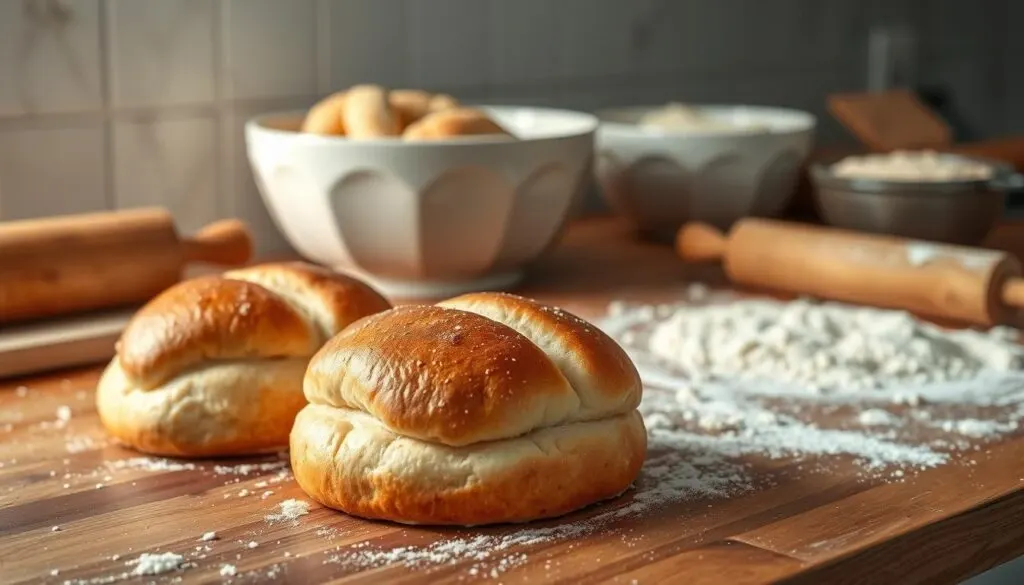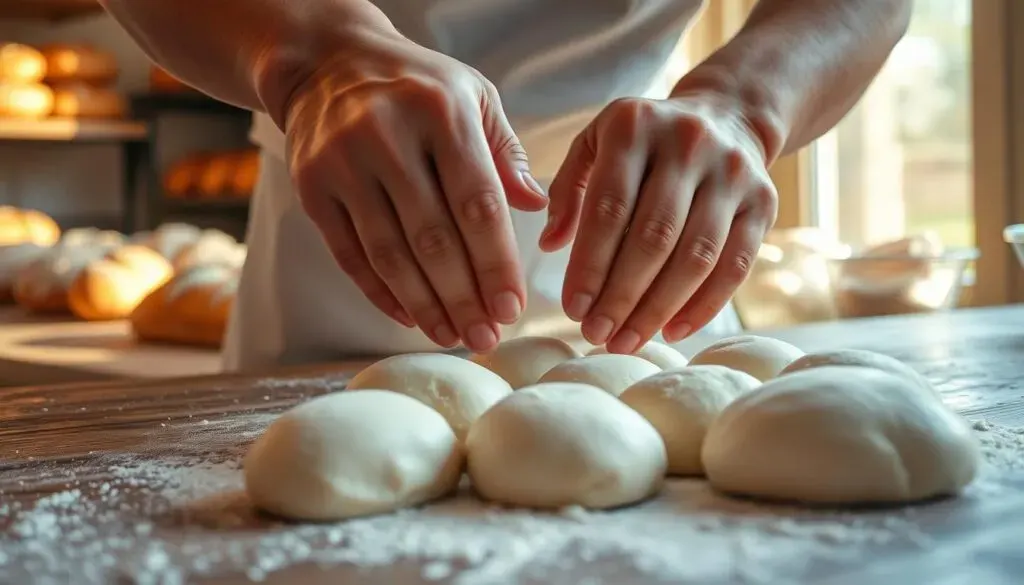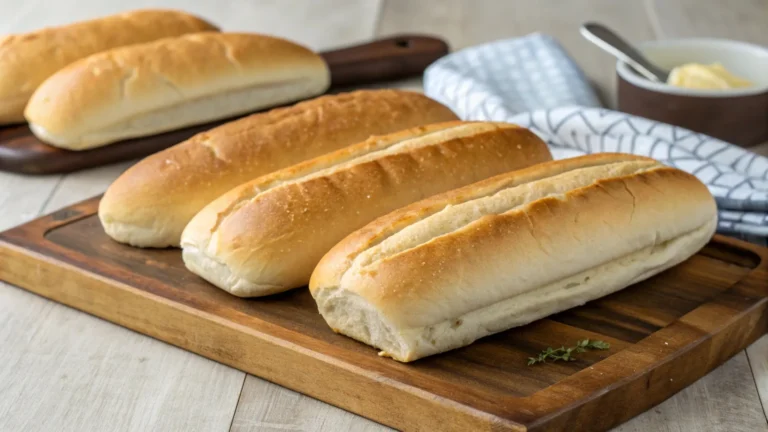Deli Sandwich Rolls Recipe: 7 Tips for the Best Taste

I love making my own breads and rolls at home. The deli sandwich roll is one of my favorites. It’s so satisfying to bite into a soft, chewy roll that I made myself.
Today, I’m excited to share my easy recipe for homemade deli sandwich rolls. It will make your favorite sandwiches even better.

This recipe needs only 9 simple ingredients. It makes a hoagie that’s great for French dip sandwiches, meatball sliders, or classic subs. The rolls have a crisp outside and a soft inside, just like your favorite deli.
Whether you’re experienced in baking or new to the kitchen, this recipe will be a hit. It’s sure to become a favorite in your family.
Table of Contents
Essential Ingredients for Perfect Sandwich Rolls
Making the perfect homemade bakery-style rolls or soft dinner yeast rolls needs the right ingredients. You’ll need basic pantry items and special touches to make the dough amazing. Let’s look at what you need to make your sandwich rolls truly special.
Basic Pantry Staples
The base of any great sandwich roll recipe starts with common kitchen items. These are likely things you already have:
- Warm water
- Instant yeast
- Granulated sugar
- Honey
- All-purpose flour
- Salt
- Unsalted butter
Special Ingredients for Enhanced Flavor
To make your homemade rolls even better, add some special ingredients. They’ll give your rolls a unique taste:
- Egg white (for the egg wash)
- Milk (for the egg wash)
Equipment Needed
You’ll also need the right tools to make your sandwich rolls perfect. Here’s what you’ll need:
- A stand mixer with a paddle attachment
- A Silpat mat or parchment paper
- A baking sheet
- A sharp knife or blade for scoring the dough
With these ingredients, special touches, and the right tools, you’re ready to make soft, bakery-style sandwich rolls. They’ll take your homemade deli creations to the next level.
Why Make Your Own Deli Sandwich Rolls Recipe
Creating delicious deli-style sandwiches starts with the bread. Making your own easy bread recipe beats store-bought sandwich bread or lunch rolls. It brings many benefits to your lunchtime.
Customizing your sandwich bread is easy. You can try different flavors and textures. This is hard to do with pre-made bread.
Homemade lunch rolls are always fresh and free from preservatives. Say goodbye to stale bread. Your homemade rolls will be soft and chewy.
Baking your own easy bread recipe can save money. You only need basic ingredients. This way, you can enjoy quality without spending a lot.
Don’t settle for bad sandwich bread. Make your own lunch rolls at home. It’s all about customization, freshness, and saving money. Get ready to make your sandwiches better and impress your taste buds.

Preparing the Yeast Dough
Starting with the perfect crusty bread rolls, hoagie rolls, or sub roll recipe means making great yeast dough. This step is key for the rolls’ texture and taste.
Proper Water Temperature Tips
First, warm the water for the yeast. It should be between 105°F and 115°F. This helps the yeast activate and start the dough rising. Add sugar and honey to the water to boost the dough’s taste.
Mixing and Kneading Techniques
In a stand mixer with a dough hook, mix the flour on low for 4 minutes. Then, mix on medium speed and add salt slowly. Add cold, cubed butter bit by bit, mixing well before adding more. The dough will look uneven at first but will smooth out as you mix. Knead for 8-10 minutes until it’s stretchy and smooth.
| Ingredient | Amount |
|---|---|
| Active Dry Yeast | 21 grams (2 tablespoons) |
| Warm Water | 420 grams (2 cups) |
| Sugar | 60 grams (¼ cup) |
| All-Purpose Flour | 390 grams (2 ½ cups) |
| Bread Flour | 390 grams (2 ½ cups) |
| Salt | 18 grams (2 teaspoons) |
| Vegetable Oil | 70 grams (⅓ cup) |
Follow these steps to make the perfect dough for your crusty bread rolls, hoagie rolls, or sub roll recipe.

The Secret to Soft and Chewy Texture
To get soft and chewy sandwich rolls, you need to hydrate the dough right. Also, adding butter is key. The dough should be a bit sticky but easy to handle. Don’t overdo it with flour, or your rolls will be heavy.
Using cold butter in small amounts makes a big difference. It helps the rolls stay soft inside and gives them a tender crumb. By doing these simple steps, you can make your submarine sandwich roll recipe better than any bakery’s.
- Maintain the right dough hydration level for a soft, chewy texture.
- Incorporate cold butter in small increments to achieve a tender crumb.
- Resist the urge to add too much flour, as this can lead to heavy, dense rolls.
| Ingredient | Amount |
|---|---|
| Bread Flour | 6 cups |
| Lukewarm Water | 1 3/4 cups (at 110°F) |
| Active Dry Yeast | 1 (1/4-ounce) envelope or 2 1/4 teaspoons |
| Eggs | 3 large |
| Unsalted Butter | 4 tablespoons, plus extra for bowl |
Follow these tips and use the right ingredients. You’ll make soft, chewy, and flavorful homemade sandwich rolls. They’ll take your deli-style sandwiches to the next level.

First Rise and Dough Development
After mixing your dough, it’s time for the yeast to do its job. Put the dough in a lightly oiled bowl. Cover it with a clean towel and let it rise for 1 to 2 hours in a warm, draft-free spot. The dough should double in size, becoming very puffy and airy.
Creating the Perfect Environment
To help your dough rise right, find a warm, cozy spot in your kitchen. Stay away from cold, drafty areas. The yeast needs warmth to grow well. Good places to let the dough rise include:
- Inside the oven with the light turned on (but the oven itself turned off)
- On top of the refrigerator
- In a turned-off microwave or oven
- Near a sunny window
Signs of Properly Risen Dough
After the first rise, your italian sub bread or artisan bread rolls dough should be double in size. It should feel light and airy. Gently press your finger into the dough – if it slowly springs back, it’s ready for the next step. If it springs back quickly or hasn’t expanded much, give it more time.
Once the dough is ready, gently deflate it. Then, divide it into equal pieces, ready for shaping. This brief rest will make the dough easier to shape.

Shaping Techniques for Professional-Looking Rolls
Getting the right shape for your homemade rolls is key for that bakery-style look. Whether you’re making classic bakery-style rolls or hoagie rolls, knowing how to shape them is important.
To shape the rolls, start by stretching each piece of dough into an oval. Then, pull down the bottoms to smooth out the tops. Pinch the ends underneath to make a seamless, uniform surface. For hoagie roll shapes, flatten each piece into a rectangle. Fold one end up like an envelope, then turn it 180 degrees and fold the other end over the first. Repeat until you get the hoagie shape you want, then pinch the seam and end seams shut.
- Gently stretch each piece of dough into an oval.
- Smooth out the tops by pulling down the bottoms and pinching the ends underneath.
- For hoagie rolls, flatten the dough into a rectangle, then fold one end up like an envelope and the other end over the first, repeating until the desired shape is achieved.
- Pinch the seam and end seams shut to ensure a professional, bakery-quality appearance.

Mastering these simple shaping techniques can take your homemade rolls to the next level. You’ll get that bakery-fresh look and texture. Enjoy serving up top-notch bakery-style rolls and hoagie rolls from your kitchen.
Second Rise and Preparation for Baking
After shaping your crusty bread rolls or sub rolls, it’s time for the second rise. Place the shaped rolls on a prepared baking sheet. Cover them lightly with a towel or greased plastic wrap. Let them rise for 45 minutes to 2 hours. This second rise is key for a soft and chewy texture.
Adding Toppings and Scoring
Before baking, brush the tops of your rolls with an egg wash. Mix beaten egg white with milk for this. It gives them a beautiful golden-brown sheen. You can also sprinkle sesame seeds or poppy seeds for a classic sub roll recipe look.
Use a sharp knife or blade to score the top of each roll. Scoring helps the rolls rise evenly. It also creates appealing splits and cracks on the surface.
Steam Baking Method
To get that perfect crusty bread rolls look, try steam baking. Preheat a rimmed metal baking sheet in the oven. Just before placing the rolls in, pour a small amount of water onto the hot baking sheet. This creates a burst of steam in the oven. It helps develop that perfect crisp crust.
Baking Tips for Golden Brown Perfection
Getting your homemade sandwich rolls to a perfect golden-brown crust is key. It makes them look and taste better. Here are some tips to help your easy bread recipe turn out just right:
- Preheat your oven to a high temperature, between 375°F and 425°F. This creates a hot, even baking environment.
- Bake the rolls for 16 to 22 minutes. Keep an eye on them. They should be lightly golden and hard when tapped.
- Use an instant-read thermometer to check the internal temperature. It should be between 200°F and 210°F for perfectly baked rolls.
- For a crisp, shiny crust, brush the hot rolls with melted butter right after baking. This keeps them soft and chewy inside.
The crust might feel hard when the rolls come out of the oven. But it will soften as they cool. With these tips, you’ll make homemade sandwich rolls that will wow everyone.
| Baking Temperature | Baking Time | Internal Temperature | Crust Finish |
|---|---|---|---|
| 375°F – 425°F | 16 – 22 minutes | 200°F – 210°F | Lightly golden, crisp |

Cooling and Storage Methods
After baking your sandwich bread or lunch rolls, let them cool completely. This step, which takes 1 to 2 hours, is key. It lets the bread finish baking inside and get the right texture.
Once cooled, store the rolls in an airtight container or plastic bag. They can stay fresh for 5-7 days at room temperature. For longer storage, freeze them. Wrap each roll in plastic or put them in a freezer-safe bag for up to 3 months.
To enjoy frozen rolls, thaw them at room temperature or reheat in the oven. This will bring back their fresh taste and texture.
By cooling and storing your sandwich bread and lunch rolls correctly, they’ll stay fresh and tasty. This way, you can enjoy your homemade treats for days.
Best Uses for Your Homemade Rolls
Mastering homemade deli sandwich rolls opens up a world of tasty sandwich options. These rolls are ideal for both classic and creative sandwiches.
Sandwich Combinations
- French Dip Sandwiches
- Meatball Subs
- Cheesesteaks
- Italian Subs with deli meats, cheese, and Italian seasonings
- Party Sandwiches with turkey, ham, and your favorite condiments
- Tuna Salad Sandwiches
For a casual touch, shape the dough into sliders. This makes for delicious, bite-sized sandwiches.
Serving Suggestions
Enjoy your rolls warm with butter for a classic deli feel. Or, use them for your favorite deli sandwiches, like Italian sub bread or deli sandwich rolls recipe. The possibilities are endless!
Troubleshooting Common Issues
Baking homemade yeast rolls can be rewarding, but bakers face common challenges. Don’t worry, we’ve got tips to help your yeast rolls turn out great every time.
Dough Consistency Challenges
Working with dough that’s too wet or too dry can be hard. To fix a wet dough, add more flour slowly until it’s just tacky. For a dry dough, add more water slowly until it’s smooth.
Yeast Activation Issues
Make sure your yeast is fresh and the water is at the right temperature. The best water temperature for yeast is 105-115°F. If your dough isn’t rising, check that your room is warm, around 80-85°F.
Uneven Baking
For even baking, make sure all rolls are the same size. If some are browning too fast, cover them with foil or lower the oven temperature.
| Common Issue | Troubleshooting Solution |
|---|---|
| Dough too wet or dry | Adjust flour or water amounts as needed |
| Dough not rising properly | Ensure fresh yeast and warm environment |
| Uneven baking | Ensure equal sizing, cover with foil if browning too fast |
By tackling these common problems, you’ll bake perfect homemade yeast rolls every time. Happy baking!

Conclusion
Making your own homemade sandwich rolls at home is a rewarding experience. It results in fresh, delicious bread perfect for any sandwich. With practice, you’ll get the hang of the dough and can customize the deli sandwich rolls recipe to your liking.
Even if your first try isn’t perfect, you’re still making fresh, homemade bread. This bread will make your sandwiches even better.
By following the step-by-step instructions and using helpful tips and tricks, you can make bakery-quality sandwich rolls at home. You can choose from a classic Kaiser roll or try different flavors and textures. This recipe is a great base for endless sandwich possibilities.
So, don’t be afraid to get your hands a little doughy and dive into homemade bread baking. With a bit of time and practice, you’ll be making fresh, soft, and flavorful sandwich rolls. Your family and friends will love your culinary skills.
FAQ
What are the basic ingredients needed to make homemade deli sandwich rolls?
You’ll need warm water, instant yeast, and granulated sugar. Also, honey, all-purpose flour, salt, and unsalted butter are essential.
What special ingredients are used for enhanced flavor?
For extra flavor, an egg white and milk wash is brushed on the rolls before baking.
What equipment is needed to make these homemade deli rolls?
You’ll need a stand mixer with a paddle attachment. Also, a silpat mat or parchment paper, a baking sheet, and a sharp knife or blade for scoring.
Why should I make my own deli sandwich rolls instead of buying them?
Making your own rolls lets you customize them. They’re fresher and often cheaper than store-bought. Plus, they have no preservatives and taste better.
How do I properly hydrate the dough and incorporate the butter for a soft, chewy texture?
Don’t over-mix the dough to avoid heavy rolls. It should be slightly sticky. Cold butter added gradually makes the rolls soft inside.
How do I ensure the rolls rise properly during the two rises?
Place the dough in a lightly oiled bowl, cover it, and let it rise in a warm place. It should double in size and puff up a lot.
What are the best techniques for shaping the rolls?
Stretch each piece into an oval, then pull down the bottoms. Smooth out the tops and pinch the ends. For hoagies, fold the dough like an envelope and pinch the seams.
How do I ensure even baking and a professional-looking finish on the rolls?
Brush the rolls with an egg wash before baking. Score the top with a sharp knife. Use steam baking for a professional look.
How do I store the homemade deli sandwich rolls?
Cool the rolls completely on a wire rack before storing. Store them in an airtight container or plastic bag at room temperature for 5-7 days. Freeze for up to 3 months.
What are some of the best ways to use these homemade deli sandwich rolls?
Use them for French dip, meatball subs, and cheesesteaks. They’re great for Italian subs, party subs, and tuna salad sandwiches. Shape them into sliders for smaller sandwiches.
Tell us how u found this recipe?
There are no reviews yet. Be the first one to write one.






